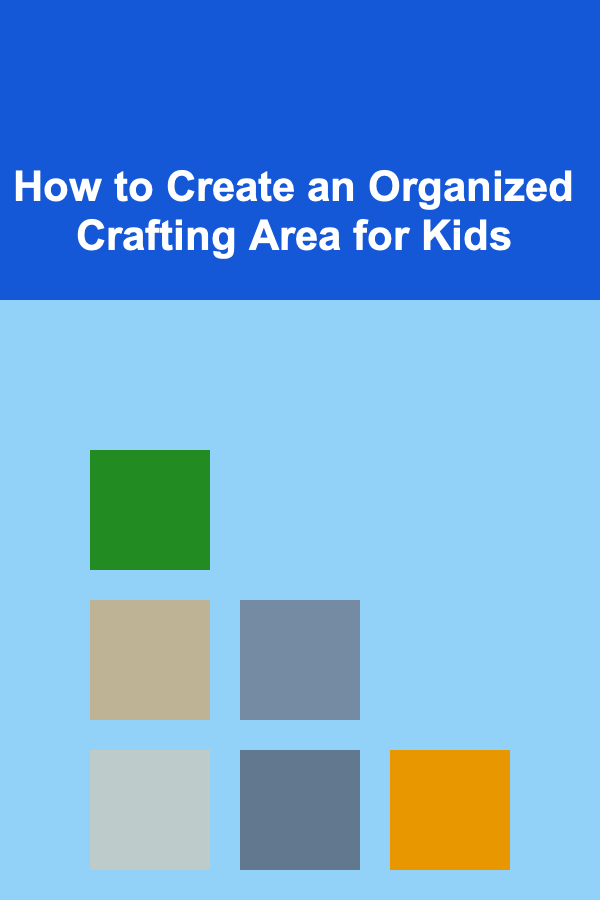
How to Organize Your Craft Library with Books and Magazines
ebook include PDF & Audio bundle (Micro Guide)
$12.99$9.99
Limited Time Offer! Order within the next:

Crafting is a delightful and fulfilling pastime that not only allows individuals to express their creativity but also provides a sense of accomplishment upon completing a project. A well-organized craft library can serve as a valuable resource for inspiration, techniques, and ideas. However, as your collection of craft books and magazines grows, it can quickly become overwhelming. This comprehensive guide will explore how to organize your craft library effectively, ensuring easy access to resources when you need them most.
Understanding the Importance of Organization
Enhancing Creativity
A well-organized craft library serves as an inspirational cornerstone for any crafter. It allows for easy access to materials, encouraging experimentation and innovation. When you can easily find your books and magazines, you're more likely to dive into new projects or revisit old favorites.
Saving Time
Time is precious in our busy lives, and searching for that one specific book or magazine can be frustrating. An organized craft library saves time by allowing you to quickly locate the resources you need.
Reducing Clutter
An organized space can significantly reduce clutter and stress. When items are neatly stored and sorted, it enhances your overall crafting experience, making it enjoyable rather than chaotic.
Encouraging Use of Resources
When your craft library is organized and inviting, you'll be more inclined to use it. Whether it's learning a new technique or finding inspiration, an accessible library encourages exploration and use of your materials.
Assessing Your Collection
Inventory Check
The first step in organizing your craft library is to assess what you have. Here's how to approach this task:
- Gather All Materials: Collect all your craft books and magazines in one location. This could be a table or designated crafting area.
- Sort Through Items: Go through each item, taking note of its condition and relevance. Are there outdated techniques? Do some books no longer interest you?
- Create an Inventory List: Document what you have, including titles, authors, and categories. This list can serve as a reference for future organization or when considering additional purchases.
Assessing Frequency of Use
As you go through your collection, identify which books and magazines you use most often. This insight will influence how you choose to store them for easy access later on.
Choosing the Right Storage Solutions
Factors to Consider
When selecting storage solutions for your craft library, consider:
- Space Availability: Evaluate how much space you have for storage---shelves, bins, or cabinets.
- Accessibility: Arrange items based on how frequently you use them. You want to ensure that your most-used resources are within easy reach.
- Visibility: Choose storage options that allow you to see contents at a glance. Clear containers or open shelving can help with this.
- Durability: Ensure that your storage solutions are sturdy enough to support the weight of your books and magazines without sagging or collapsing.
Storage Options
- Bookshelves: Traditional bookshelves are classic and effective. They can hold a large number of books and magazines, allowing for easy access.
- Baskets and Bins: Woven baskets or plastic bins can keep magazines contained and organized. Label each bin for quick identification.
- Filing Cabinets: For magazines, filing cabinets with hanging folders can provide structured organization. This method allows for easy flipping through issues.
- Floating Shelves: These can save floor space while providing a stylish way to display books and magazines.
- Rolling Carts: If you frequently move between crafting spaces, a rolling cart can store your library materials in one mobile location.
Categorizing Your Collection
The Benefits of Categorization
Organizing your craft library into categories makes it easier to locate specific resources. It streamlines the process and enhances usability.
Suggested Categories
Here are some potential categories for organizing your craft library:
-
Type of Craft: Separate books and magazines based on the type of craft they cover. For example:
- Knitting
- Crochet
- Scrapbooking
- Sewing
- Painting
-
Project Type: Organize by project types, such as home décor, gifts, or seasonal crafts.
-
Skill Level: Group materials based on difficulty levels (beginner, intermediate, advanced). This can help you choose the right resource for your current skill level.
-
Themes or Seasons: Categorize based on themes (e.g., holidays, nature) or seasons (spring, summer), making it easier to find relevant projects throughout the year.
-
Authors or Designers: If you have multiple works from particular authors or designers, consider organizing by creator for ease of access.
-
Magazine Issues: For magazines, consider sorting them by date or volume number for chronological organization.
Labeling Your Library
The Importance of Labels
Labels aid in quick identification and help maintain organization over time. They reduce the time spent searching for specific items, allowing for a more efficient workflow.
Labeling Techniques
- Printed Labels: Use a label maker or computer software to create clear, professional-looking labels.
- Handwritten Labels: For a personal touch, write directly on adhesive labels or tags using permanent markers.
- Color-Coded Labels: Implement a color-coding system to signify different categories. This visual cue helps quickly identify sections.
Regular Updates
As your collection evolves, regularly update your labels to reflect new additions or changes in organization. This practice ensures ongoing functionality.
Maintaining Your Organized Craft Library
Regular Audits
Set a schedule for regular audits of your collection. Every 6 to 12 months, reevaluate the contents of your library, removing outdated or unneeded items. This proactive approach helps maintain organization.
Cleanliness
Keep your library clean and dust-free. Regularly wipe down shelves, bins, and other surfaces to prevent dust accumulation, which can damage paper materials.
Adaptation
Be flexible with your organization system. As your interests evolve or as you accumulate more materials, don't hesitate to adapt your categories, storage solutions, and labels.
Utilizing Digital Resources
Inventory Management Apps
Consider using digital tools to enhance your library's organization. Inventory management apps can help you track your collection, including details such as:
- Title
- Author
- Category
- Condition
- Purchase date
Some popular inventory management options include:
- LibraryThing: Allows users to catalog their books and share their collections.
- Goodreads: Primarily for books but can be adapted for craft materials.
- Evernote: Useful for creating lists and keeping track of resources.
Digital Patterns and Ideas
Many crafters now utilize digital resources for patterns and tutorials. Consider storing these materials in organized folders on your computer or cloud storage. Label and categorize them similarly to your physical library for consistency.
Storing Online Subscriptions
If you subscribe to digital magazines or online platforms, create a dedicated folder for these resources. Ensure they are accessible and categorized to fit your needs.
Common Challenges and Solutions
Challenge: Overwhelming Quantity of Materials
Solution: Implement a one-in, one-out policy. For every new book or magazine you acquire, consider donating or selling one from your collection.
Challenge: Difficulty Finding Specific Titles
Solution: Utilize a comprehensive inventory list, both in physical and digital formats. Cross-reference your physical items against your digital records to streamline searches.
Challenge: Limited Space
Solution: Maximize vertical space through wall-mounted shelves or utilize under-bed storage for less frequently used materials. Consider decluttering to free up space.
Challenge: Keeping Up with New Trends
Solution: Stay informed about new releases in the crafting community. Consider designating a small section of your library for the newest additions, rotating them out as they age.
Case Studies: Successful Craft Library Organization
Case Study 1: The Quilter
Context: A quilter had amassed a vast collection of quilting books and magazines, leading to disorganization and frustration.
Solution: She categorized her collection by quilt type (patchwork, applique, etc.) and created a binder system for individual projects. Each binder contained instructions and fabric samples.
Outcome: The quilter reported a significant increase in project completion, as she could easily locate resources and reference materials while working.
Case Study 2: The Multi-Crafter
Context: A multi-crafter struggled to balance various interests, leading to a chaotic collection of mixed media books and magazines.
Solution: He implemented a color-coded system based on craft types, utilizing open shelving to maximize visibility. He also integrated a digital inventory system for digital patterns.
Outcome: The multi-crafter found it easier to switch between hobbies and reported feeling more inspired due to the organized space.
Conclusion
Organizing your craft library with books and magazines is essential for enhancing creativity, saving time, and reducing clutter. By assessing your collection, choosing appropriate storage solutions, categorizing materials, and maintaining a labeling system, you can create an inviting and functional workspace that fosters inspiration.
Adapting to changing needs and regularly auditing your collection will ensure that your craft library remains relevant and accessible. Embracing both physical and digital resources can further enrich your crafting experience. With a well-organized craft library, you're ready to dive into new projects with confidence and joy!

How to Build a Morning Routine Checklist for Daily Success
Read More
How to Create an Organized Crafting Area for Kids
Read More
How to Establish a System for Seasonal Clothing Changes
Read More
How to Incorporate Multi-Functional Furniture into Your Hobby Room
Read More
How to Make a Checklist for Building a Marketing Plan for Product Launch
Read More
Using a One-Page Website to Build a Strong Online Presence
Read MoreOther Products

How to Build a Morning Routine Checklist for Daily Success
Read More
How to Create an Organized Crafting Area for Kids
Read More
How to Establish a System for Seasonal Clothing Changes
Read More
How to Incorporate Multi-Functional Furniture into Your Hobby Room
Read More
How to Make a Checklist for Building a Marketing Plan for Product Launch
Read More